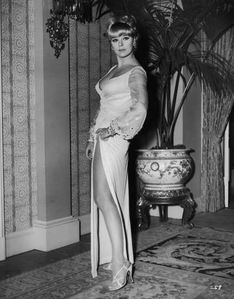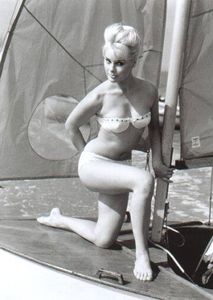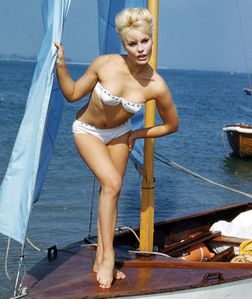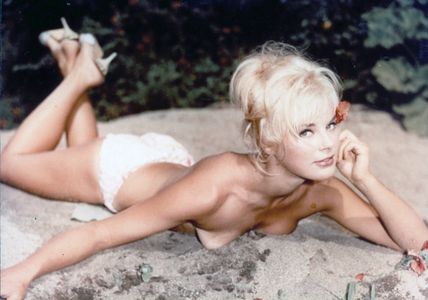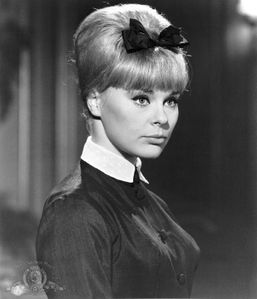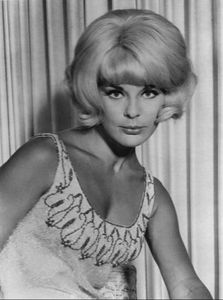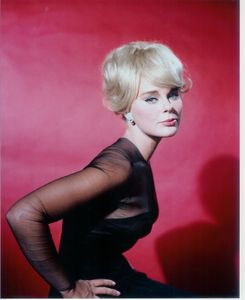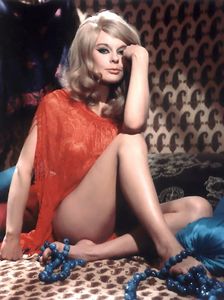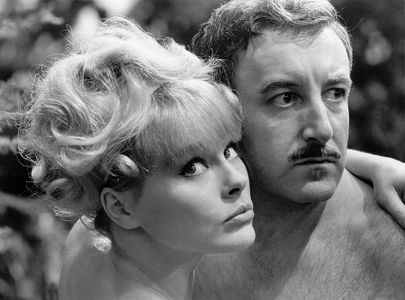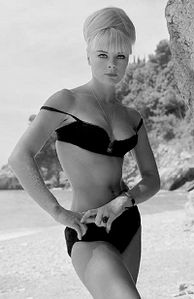Elke Sommer
Elke Sommer (born 5 November 1940), born Elke Baronesse von Schletz, is a German actress, entertainer and artist. She appeared in numerous films in her heyday throughout the 1960s and 1970s, including roles in The Pink Panther sequel A Shot in the Dark (1964), the Bob Hope comedy Boy, Did I Get a Wrong Number! (1966), Agatha Christie's And Then There Were None (1974), and a memorable performance in the British Carry On series in Carry On Behind (1975).
Early life
Sommer was born in Berlin to Baron Peter von Schletz, a Lutheran minister, and his wife Renata, nee Topp. During the Second World War (in 1942), the family was evacuated to Niederndorf, a village near Erlangen, a small university town in Franconia, where she attended a university-preparatory high school. Her father died when she was 14 years old. She passed her college entrance exam. After this, she moved to the UK to work as an au pair in order to earn a living and to perfect her English. There, she also received some training as an interpreter.
Career
Discovery
She was spotted by film director Vittorio De Sica while on holiday in Italy, and she began appearing in films there in 1958. Also that year, she changed her surname from Schletz to Sommer. She quickly became a noted sex symbol and moved to Hollywood in the early 1960s. She became one of the more popular pin-up girls of the time and posed for several pictorials in Playboy magazine, including the September 1964 and December 1967 issues.
Sommer became one of the top film actresses of the 1960s. She made 99 film and television appearances from 1959 to 2005, including A Shot in the Dark (1964) with Peter Sellers, The Art of Love (1965) with James Garner and Dick Van Dyke, The Oscar (1966) with Stephen Boyd, Boy, Did I Get a Wrong Number! (1966) with Bob Hope, the Bulldog Drummond extravaganza Deadlier Than the Male (1966), The Wrecking Crew (1968) with Dean Martin, and The Wicked Dreams of Paula Schultz (1968); in each of these films she was the leading lady.
The 1960s
In 1964, she won a Golden Globe award as Most Promising Newcomer Actress for The Prize, a film in which she co-starred with Paul Newman and Edward G. Robinson.
A frequent guest on television, Sommer sang and participated in comedy sketches on episodes of The Dean Martin Show and on Bob Hope specials, made 10 appearances on The Tonight Show Starring Johnny Carson, and was a panelist on the Hollywood Squares game show many times between 1973 and 1980, when Peter Marshall was its host.
The 1970s
Sommer's films during the 1970s included the thriller Zeppelin, in which she co-starred with Michael York, and a remake of Agatha Christie's murder mystery Ten Little Indians. In 1972, she starred in two Italian horror films directed by Mario Bava: Baron Blood and Lisa and the Devil. The latter was re-edited (with 1975 footage inserted) to make a different film titled House of Exorcism. Sommer went back to Italy to act in additional scenes for Lisa and the Devil, which its producer inserted into the film to convert it to House of Exorcism against the wishes of the director.
In 1975, Peter Rogers cast her in the British comedy Carry On Behind as the Russian Professor Vrooshka. She became the Carry On films' joint highest-paid performer, at £30,000; this was an honor that she shared with Phil Silvers (who starred in Follow That Camel).
Most of her movie work during the decade came in European films. After the 1979 comedy The Prisoner of Zenda, which reunited her with Sellers, the actress did virtually no more acting in Hollywood films, concentrating more on her artwork.
Sommer also performed as a singer, recording and releasing several albums.
She provided the voice for Yzma in the German release of The Emperor's New Groove.
Later work
In the 1980s, Sommer hosted a syndicated programme titled The Exciting World of Speed and Beauty.
After the 1990s, Sommer concentrated more on painting than on acting. As an actress, she had worked in half a dozen countries learning the languages (she speaks seven languages) and storing images which she has expressed on canvas. Her artwork shows a strong influence from Marc Chagall.
Sommer was embroiled in a long-running feud with Zsa Zsa Gabor that began in 1984 when both appeared on Circus of the Stars. This had escalated into a multimillion-dollar libel suit by 1993, resulting in Sommer being awarded $3.3 million in damages from Gabor and her husband, Frederick von Anhalt, for defaming her in interviews published in a pair of German publications in 1990.
In 2001, a Golden Palm Star on the Palm Springs Walk of Stars was dedicated to her.
Personal life
In 1964, Sommer married Hollywood columnist Joe Hyams (6 June 1923 – 8 November 2008), who was 17 years her senior, in Las Vegas.
Then she met Wolf Walther, eight years her junior and the managing director of a luxury hotel, Essex House in New York City. They were married on 29 August 1993 in Franconia. In a 2014 interview, Sommer described how she and Walther met:
- "I was in New York City starring in Tamara and had to stay there for four months. So, I had to find an apartment but they were excruciatingly expensive, tiny and loud. As I knew the managing director of the Essex House, I wanted to talk to him about renting a room but the hotel had a new managing director, a man by the name of Wolf Walther. So we met. For him, it was love at first sight. For me, it took a little longer, but not much longer. As you may know, Tamara is a play in which the audience follows the actor of their choice, and as you may also know, my husband is 6'5" and hard to miss. I saw him every night in the audience, following me. Every night. And that was the beginning of the greatest love story of my life, still unfolding and getting better by the day."
As of May 2017, Sommer was living in Los Angeles, California.
- Elke Sommer gallery
Bound for Hollywood

Elke Sommer, age 22, all roped up in a West German movie called Violent Youth, which may or may not also go by the title Sweet Ecstasy or Violent Ecstasy. (1962)
IMDB bio
This gorgeous Teutonic temptress was one of Hollywood's most captivating imports of the 1960s. Blonde and beautiful, Berlin-born Elke Sommer, with her trademark pouty lips, high cheekbones and sky-high bouffant hairdos, proved irresistible to American audiences, whether adorned in lace or leather, or donning lingerie or lederhosen . She was born in Berlin-Spandau on November 5, 1940 with the unlikely name of Else Schletz-Ho to a Lutheran minister and his wife. The family was forced to evacuate to Erlangen, during World War II in 1942, a small university town in the southern region of Germany. It was here that her parents first introduced her to water colors and her lifelong passion for painting was ignited. Her father's death in 1955, when she was only 14, interrupted her education and she relocated to Great Britain, where she learned English and made ends meet as an au pair. She eventually attended college back in Germany and entertained plans to become a diplomatic translator but, instead, decided to try modeling.
After winning a beauty title ("Miss Viareggio Turistica") while on vacation in Italy, she caught the attention of renowned film actor/director Vittorio De Sica and began performing on screen. Her debut film was in the Italian feature, Men and Noblemen (1959), which starred DeSica and was directed by Giorgio Bianchi. Following a few more Italian pictures, which included her first starring role in Love, the Italian Way (1960), also directed by Bianchi, Elke began making a name for herself in German films, as well, and gradually upgraded her status to European sex symbol. A pin-up favorite, she appeared fetchingly in both dramas and comedies, with such continental features as Daniella by Night (1961), Sweet Violence (1962) and her first English-speaking picture, Why Bother to Knock (1961), to her credit.
Hollywood naturally became intrigued and she moved there in the early 1960s to try and tap into the American market. Her sexy innocence made a vivid impression in the all-star, war-themed drama, The Victors (1963), the Hitchcock-like thriller, The Prize (1963), for which she won a "Best Newcomer" Golden Globe Award, and, especially, A Shot in the Dark (1964), the classic bumbling comedy where she proved a shady and sexy foil to Peter Sellers' Inspector Clousseau. She grew in celebrity, which was certainly helped after showing off her physical assets, posing for spreads in Playboy Magazine. In the meantime, she was appearing opposite the hunkiest of Hollywood actors including Paul Newman, James Garner, Glenn Ford, and Stephen Boyd.
Always a diverting attraction in spy intrigue or breezy comedy, she was too often misused and setbacks began to occur when the quality of her films began to deteriorate. The tacky Hollywood entry, The Oscar (1966), the Bob Hope misfire, Boy, Did I Get a Wrong Number! (1966), the tired Dean Martin "Matt Helm" spy spoof, The Wrecking Crew (1968), and her title role in the tasteless Cold War comedy, The Wicked Dreams of Paula Schultz (1968), starring Hogan's Heroes (1965) alumnus, Bob Crane, Werner Klemperer, and Leon Askin, proved her undoing.
The multilingual actress, whose career took her to scores of different countries over time and benefited from speaking seven languages fluently, resorted to a number of low-budget features in Europe, including two Italian horror movies directed by Mario Bava that have now gone on to become cult classics: Baron Blood (1972) and The Exorcist (1973) rip-off, Lisa and the Devil (1973). The latter movie actually was a guilty pleasure. "Lisa" was re-released in 1975 as "The House of Exorcism" and added more footage of a demonic Elke, Linda Blair style, spewing frogs, insects, green pea soup, and a slew of cuss words! In England, she good-naturedly appeared in the "comedy" films, Percy (1971), and its equally cheeky sequel, It's Not the Size That Counts (1974), which starred Hywel Bennett (later Leigh Lawson) as the first man to have a penis transplant(!). She also showed up in one of the later "Carry On" farces, entitled Carry on Behind (1975).
Elke fared better on television, where she appeared in the television pilot, Probe (1972), opposite Hugh O'Brian, as well as the well-made 1980s miniseries, Inside the Third Reich (1982), Jenny's War (1985), Anastasia: The Mystery of Anna (1986) and Peter the Great (1986). In addition, she made a few TV guest appearances on such popular shows as "Fantasy Island," "The Love Boat" and "St. Elsewhere."
A delightful personality on the talk show circuit, the lovely Elke also made appearances as a cabaret singer and, in time, put out several albums. She found a creative outlet on stage too with such vehicles as "Irma la Douce", "Born Yesterday", "Cactus Flower", "Woman of the Year" and "Same Time, Next Year".
Dividing her time between here and in Germany in later years, she added her usual charm to films both here (Lily in Love (1984), Severed Ties (1992)), and in Germany (Himmelsheim (1988), Flashback (2000), Life Is Too Long (2010)).
The veteran actress has since focused more time on book writing and painting than she has on acting. Holding her first one-woman art show at the McKenzie Galleries in Beverly Hills in 1965, her artwork bears an exceptionally strong influence to Marc Chagall and she, at one point, hosted a mid-1980s PBS series ("Painting with Elke"), that centered on her artwork, which has now exhibited and sold for more than 40 years. Nevertheless, on occasion, she tackles an acting role, often in her native Germany. Divorced from writer and journalist Joe Hyams, whom she met when he interviewed her for a Hollywood article (he recently died in November 2008), she has been married since 1993 to hotelier Wolf Walther.
- - IMDb Mini Biography By
- Gary Brumburgh / gr-home@pacbell.net
Chat rooms • What links here • Copyright info • Contact information • Category:Root


